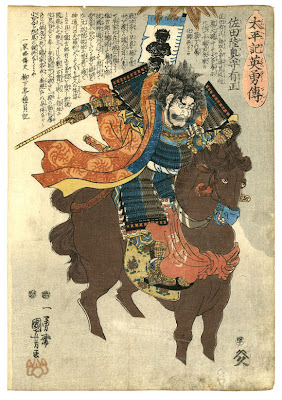At the Ichi Joji blog, the author (Christopher Hellman, who is the author of The Samurai Mind) has posted a review of a new book on the historical Miyamoto Musashi, as well as some comments on other existing books on the famous samurai. I've excerpted a portion below. The full article may be read here.
The commonly told of Miyamoto Musashi is a much patched version taken from a variety of sources of varying reliability, stitched together in what has become a familiar pattern, including large doses of speculation and outright fiction. Of course, much of the fiction comes from Yoshikawa Eiji's novel, which many of the subsequent movie and TV versions were based on. His version, which drew heavily from previous versions and documents, some of which contained greater or lesser amounts of reliable historical information, has become a kind of de facto story of Musashi's life.
It was only when reading through William de Lange's new(ish) translation of the Bushu Denraiki, one of these source documents, that I realised how little detail there is on these documents in English, even when you include William Wilson's 'The Lone Swordsman' and Kenji Tokitsu's 'Miyamoto Musashi: his life and writings'. While Wilson used a wide variety of sources, he steers clear of discussing them individually, and while Tokitsu is good on Musashi's own writings (and lots else besides), he gives less information on sources about Musashi's life.
De Lange is particularly good on just this sort of thing, laying the historical context out clearly and providing extensive notes and background on the major figures involved (albeit tangentially, in some cases) in Musashi's life. He gives a valuable explanation of the relationships between these major sources, which goes a long way to helping us understand the roots of the legend.
The source documents which form the basis of what we know about Musashi's life fall into two parallel streams: the Bushu Denraiki (1727) itself, written by a 4th generation successor to the Niten Ichi-ryu, Tachibana Minehira, and the Hyoho (sometimes written as Heiho) Senshi Denki (1782) which was written by a 'grand-student' of Minehira's, who had left Fukuoka and settled in Harima, one Niwa Nobuhide, and based his account on what he could remember of Minehira's original, embroidering where necessary to fill in the gaps. This stream of knowledge was Kyushu based, and was connected with the Kuroda clan, with whom Musashi had strong connections early in his career.
The other stream was connected with the Hosokawa family, with whom Musashi was close to in his later life. Tokitsu also mention this, (though he gives different readings of the names, as well as different dates). According to de Lange, the Bukoden (1755) was compiled by Toyoda Masanaga, then rewritten in an updated and clearer form by his son, Toyoda Masashige (1776) as the Nitenki (which is perhaps the source most commonly quoted from).
In addition, there is the Kokura Hibun, which is not a document as such, but a stone monument set up by Musashi's adopted son Iori in 1654. This is the earliest account of Musashi's life, and although it is generally considered accurate, it must be considered a partisan account. (There are other, contemporary, references to Musashi, but not accounts of his life).

No comments:
Post a Comment